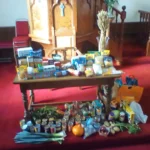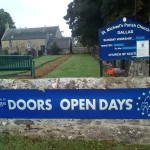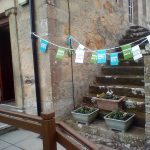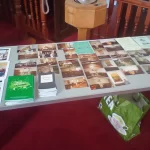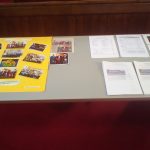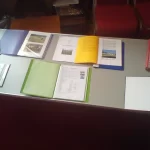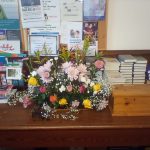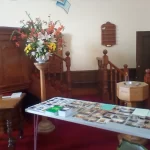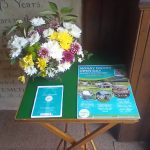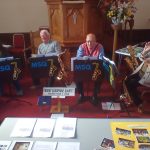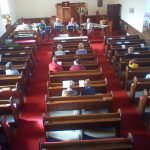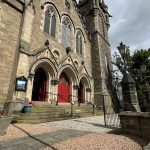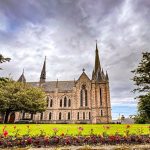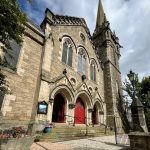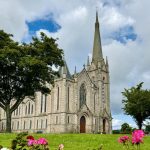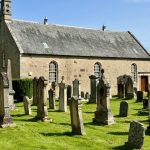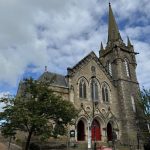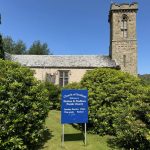Rafford Church History
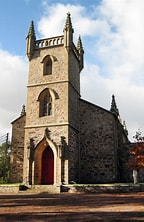
(The following history relies heavily on the Old and New Statistical Accounts of Scotland, The Lands and People of Moray prior to 1850 Part 24 (Bruce B Bishop, 2006) and Places of Worship in Scotland.)
Early tales suggest that Rafford was visited by St Ninian in the 4th Century, and that Saint Maelrubha established a monastic foundation in the area in the 7th Century; but evidence is scant.
Between 1207 and 1224, a charter from Pope Innocent III to Bricius, Bishop of Moray at Spynie, refers to lands of the “Ecclesia de Ruffus”.
Until the Reformation of 1560, the incumbent of the post of subchanter of Elgin Cathedral also held the prebendary of Rafford as well as a chapel at Ardclach, further West.
In early Presbytery records, the parish is named variously as Raffart, Raffurd or Raffurth. Other variants encountered include Ruffus, Rathefurde, Rathefd, Rathed and Rathat. Later incumbents of the parish were to suggest that the name was of Gaelic origin, and that “rath-ad” meant either a hill fort, or a “road”.
The latter may be consistent with the importance of the main road from Forres to the South of Scotland, which in older times led through Rafford to Dallas and onto Speyside at Knockando.
A later form, Raffort, finally evolved into the modern Rafford.
The parish originally extended much further North, encompassing what is now a large part of the parish of Kinloss, which was established as a new Parish in 1657; the King’s Highway from Forres to Elgin, now the A96, formed the border between them.
In 1661, the parish of Altyre, formerly a parish in its own right, and later belonging in part to the parish of St Michael’s, Dallas, was annexed to Rafford by an Act of Parliament of 1661, as compensation to Rafford for the loss of Kinloss land.
The re-organization was not popular. The Reverend J.G.Murray, in The Book of Burgie, records:
“Altyr is within two miles of Rafford, and nearly 14 miles from Dollas (sic), a desert mountain, often impassable, intervening for half of that distance, yet the annexation was obstinately opposed by its proprietor and its accomplishment required the utmost exertion of the clergy, great as their influence at that period was.”
The annexation was “for some time deferred, because the laird could not be found at home.”
Finally, on 19 August 1659, Mr James Strachan, “of Altyre and Dollas”, was “ordained to intimate publicly to the people of Altyr upon the Lord’s Day come eight days, that they were now disjoined from Dollas and annexed to the parish of Rafford, and ordained to repair to the said church in all time coming, and Mr Fullerton, minister thereof, to take up their names and have a care for them as of the rest of his parishioners.”
Things still did not proceed smoothly thereafter. In a parochial visitation in 1660, there was “a complaint made by the minister that Altyr and his people totally absented themselves from Rafford Church, and the presbytery, after application and addresses made to Altyr, to move him fairly to his duty, ordain the minister to summon before them the Laird of Altyr, and the other inhabitants of the late parish there.”
History does not relate with what success such measures were met.
Rafford contained two Burghs of Barony, Burgie and Altyre, and (possibly) a separate Burgh of Blervie. The Barron Court of Burgie is recorded as having been held there in 1724; that of Altyre in the late 1600s.
The Reverend William Stephen, reporting in 1795 for inclusion in the Old Statistical Account stated, in relation to his parish of Rafford:
Population:
According to Dr Webster’s report in 1755, the population of Rafford then amounted to 1313 souls. From an accurate list taken in 1791, the number of parishioners did not exceed 1072; of these 488 were males, and 584 females; about 840 were found examinable, i.e. above 7 years old. The number of householders was exactly 238; of whom 136 were married, and had issue; 16 were married, and had no issue; 18 were widowers; 48 widows; the remaining 20 unmarried, and 5 of them bachelors. The annual medium of births for the last 7 years, as they stand on the record, may be computed at 32; of marriages, at 8: But of the deaths no exact register has been kept, owing chiefly to that reluctance with which the tax on burials was paid by country people.
Poor:
About 40 poor are supported from the parish funds. Our capital stock is L.50 Sterling, and our weekly collections amount from 2s. 6d. to 3s.
Longevity:
Few of the natives are remarkable for longevity. There are now only about 3 individuals in the parish whose ages exceed 80, and the generality of old men seldom attain that period.
Religion:
All the parishioners, (excepting two or three families, who belong to the Secession), profess the Established Religion, and are very punctual in their attendance at church. Viewed in this light, they appear, upon the whole, a sensible, decent, and serious people. In former times, indeed, the high and mystical doctrines of Calvinism being universally taught, and admired as the only system of orthodox belief, had disseminated among the ignorant a spirit of wildness and bigotry; but this, for more than half a century past, has been gradually subsiding; and it is humbly hoped, that the rigid and fallible dogmas of men will no longer be substituted for the pure and rational truths of the gospel. On the other hand, as no earthly community is perfect, the most prevalent vices I have had occasion to remark in this, are falsehood, intemperance, sensuality, and petty thefts; these perhaps will be found most congenial to mild and temperate climates.
The ’45 uprising seems to have largely passed Rafford by; there is mention however of one Peter Matthew, a farmer of Blervie, being imprisoned in Carlisle, and dying in custody.
The original church was located on the South side of the Rafford Burn, at the main crossing point on the road from Forres to Dallas and the South. The road from Burgie to Altyre crossed at the same point, making the church the focal point of Rafford village.
The Church was rebuilt in 1754; the Manse in 1746. Leslie, writing in his Survey of the Province of Moray, in 1793, observed nonetheless that:
“The church at present is a mean fabric, but in a central location”.
By the time of the compilation of the New Statistical Account in 1842, much had changed.
The parish was now “noted for its cases of longevity”, three people living under the same roof having a combined age of 298. The Minister, in his report, attributed much of the “ameliorated condition” of the people to “the putting down of the former practice of illegal distillation of spirits”. Attempts to open more than the single public house in the village were “resisted by the heritors”, with the evident support of the Minister.
The population overall, although more temperant, was on the other hand substantially smaller, at 987, than had been the case in 1755 (1,313). A steep decline in numbers due to enclosure and combination of farms into larger units was evident: 1791 (1072); 1821 (970); 1831 (992).
The period after the wars against the French were somewhat of a boom time for the Forres area. Nelson Tower was completed in 1812. A new church building and manse were constructed, under the aegis of George Mackay, who became Rafford’s Minister on 2 May, 1816.
The manse – now a private dwelling, Rongai House – was rebuilt in 1821, at a cost of £899/8s/6d. By 1840, this “good substantial house”, set in 4 acres of glebe land, was however considered by the Reverend Mackay to be inadequate to house his growing family, and so he extended it – at his own expense.
The new church was built on a gift of Blervie land on the North side of the Burn, in 1826, “ a handsome, commodious structure, in the Gothic style, to a plan by Gillespie Graham designed to accommodate 600 sittings”.
At the time of the Minister’s reporting (1842) the “average annual amount of church collections, for all purposes, religious and charitable, was £50.”
The annual stipend, set in 1822, in rather stark contrast, stood at: “14 chalders of meal, £10 for a grass glebe, £8/8s/8d for the Communion elements and £111/17/6d in cash”.
Shortly after extending the manse, the Reverend George Mackay left the established Church of Scotland altogether following the Disruption of 1843, taking with him the majority of his parishioners, to establish a new Free Church and building in Granary (Upper Rafford), where he remained until his death in 1862. The replacement minister appointed by the established Church, Hugh McIntosh, had a couple of decades to deal with the fall-out from the Disruption, and the Reverend Mackay’s defection, until his own death in 1864. By then, Rafford village was firmly on the map, with even its own railway station, a “halt” and siding on the main route to the South, opening in 1863 (albeit closing only 2 years later).
The current church building, which is B-Listed #15589, was constructed in 1826 with roughly-coursed granite rubble – taken from the original church building across the Burn – with joints rendered in lime mortar. The gables of the old church survived until 1959, when the west gable, which was almost against the west wall of the graveyard, was finally pulled down. There is a lot of carved stonework and embellishments on the church, of fine ashlar stone. The shallow-pitched nave roof is slated, using “best Easdale or Ballachulish slates”, according to the building contract.
The south elevation of the church is dominated by the large square tower in the centre. It rises in three stories and is topped by an elaborate, pinnacled parapet. The main doorway is on the south face of the tower. It is deeply recessed and has wide chamfered margins. Flanking the doorway are mounted two large mock lanterns in stone and above is an ogee-curved hoodmould. Within are wooden double doors. Above the doorway is a single pointed-arch window with simple tracery, multi-pane glazing and a hoodmould. The third stage of the tower has a smaller pointed-arch belfry opening with louvred vents. The top of the tower is dominated by four large pinnacles, which are corbelled out at the corners and have crocketed stone spires. The parapet inbetween is corbelled out a little and has a stone balustrade.
The west elevation of the church has three large, pointed-arch windows with stepped buttresses inbetween. The windows are recessed and chamfered and have small square panes of frosted glass and hoodmoulds. They also feature simple stone tracery. The buttresses are substantial and fairly wide at the base. They step inwards as they gain height and are topped by ornate pinnacles that largely match those described on the tower, and are gabled on each face and topped by a crocketed spire.
The north gable of the church has a single, very large pointed-arch window. There is stone tracery and a hoodmould above. A memorial stained glass window (see below) was inserted in 1918, replacing the original glass. On the gable is a tall celtic cross finial.
The east elevation is now largely obscured by the attached hall. It has a buttress and pointed-arch window at the southern end, matching those on the west elevation. The hall is fairly low and single-storied, with a single-pitched roof. The south end has a small round-arched doorway and small flanking pointed-arch windows. The north and south ends of the hall are heightened by a parapet-style course, which is flat-topped and mostly hides the sloping roof. The east face of the hall is harled and has plain rectangular windows and doors.
The interior of the church today is largely the result of extensive re-modelling carried out in 1907, funded by, among others, Lord Strathcona, who gave £100. Under the aegis of P. MacGregor Chalmers of Glasgow, as architect, the original three-sided galleries were completely removed and the pews replaced. Three new gothic windows were installed in the East wall, together with a vestry at the North end. Without the galleries the roof structure has been described as “notably distant from the ground”. The walls are plastered and painted and there is a tall wooden dado running around the nave, made up, principally, of former gallery fronts.
There is a small octagonal pulpit set on a stone base with steps. It has detailed carved wooden panels with tracery and quatrefoil openings. There is a matching wooden communion table, chair, and reredos behind. To the side is an ornate stone font.
The stained glass window in the north gable was installed in 1918 as a memorial to Major Harold Bessemer Galloway, of Blervie, who was killed at the Battle of Loos in 1915. The three main panels show scenes from the life of Christ and there are smaller details including angels and a dedication. Around the walls of the nave are various memorials to local families, ministers and to Major Galloway.
A clock in the South wall was the gift of Alexander Walker, a native of Rafford and, in 1907, the President of the Colonial Bank in New York.
The vestry that was built as part of the 1907 works was re-roofed in 1950, and was incorporated into the current hall building, which dates from 1994.
PLT September 2019
